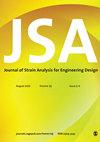A novel approach to envisage effects of boron in P91 steels through Gleeble weld-HAZ simulation and impression-creep
IF 1.4
4区 工程技术
Q3 ENGINEERING, MECHANICAL
Journal of Strain Analysis for Engineering Design
Pub Date : 2021-11-29
DOI:10.1177/03093247211061943
引用次数: 23
Abstract
This paper induced a novel methodology for the characterization of creep behavior of weld heat-affected zone (HAZ) for boron-free P91 (PM) and boron modified P91B (B-PM) steels. Gleeble-3800 thermo-mechanical simulator replicated specimens, representing coarse-grain HAZ (CGHAZ), fine-grained HAZ (FGHAZ), and inter-critical HAZ (ICHAZ). Short-term impression creep tests were conducted at 625°C/270-410MPa on PM/B-PM and their simulated HAZs after being subjected to post-weld heat treatment (PWHT) of 760°C/3 h. Microstructural characterization and local strain analyses were accomplished by electron back-scattered diffraction. Simulated microstructures of P91B-FG/ICHAZ after PWHT exhibited lath martensitic structure and large prior-austenite grain size as regards P91-FG/ICHAZ, correspondingly. Average values of local microstructural strain from local average misorientation were relatively high in B-PM and P91B-ICHAZ than PM and P91-ICHAZ, respectively. Similar observations were found for P91-CG/FGHAZ with their counterparts. Stress dependent steady-state creep-rate (SSCR) followed power-law for all specimens except PM. The minimum and maximum ranges of SSCR for P91B specimens were observed to be in a narrower range than P91 specimens. The value of stress exponent for all specimens was evaluated, and corresponding mechanisms were discussed. The analyses of microstructures and corresponding impression creep behavior of P91/P91B samples suggested that modification of 100 ppm boron to P91 steel improved creep-rupture ductility that delayed type IV failure at outer HAZ of P91 steel weldments.通过Gleeble焊接- haz模拟和压痕蠕变,设想硼在P91钢中影响的新方法
本文提出了一种表征无硼P91 (PM)和硼改性P91B (B-PM)钢焊缝热影响区蠕变行为的新方法。Gleeble-3800热机械模拟器复制样品,代表粗粒HAZ (chaz),细粒HAZ (fhaz)和临界间HAZ (ICHAZ)。在625℃/270 ~ 410mpa条件下,对经过760℃/3 h焊后热处理的PM/B-PM及其模拟haz进行了短期压痕蠕变试验。通过电子背散射衍射完成了微结构表征和局部应变分析。P91B-FG/ICHAZ经PWHT处理后的模拟显微组织表现为板条马氏体组织和较大的奥氏体晶粒尺寸。B-PM和P91B-ICHAZ的局部平均取向偏差导致的局部显微组织应变平均值分别高于PM和P91-ICHAZ。P91-CG/FGHAZ与它们的对应物发现了类似的观察结果。除PM外,所有试件的应力依赖稳态蠕变率(SSCR)均服从幂律。P91B样品的SSCR最小和最大范围比P91样品窄。对各试件的应力指数进行了计算,并讨论了相应的机理。P91/P91B试样的显微组织和相应的压痕蠕变行为分析表明,在P91钢中掺入100 ppm硼可提高P91钢的蠕变-断裂延展性,延缓P91钢焊接件外热影响区IV型破坏。
本文章由计算机程序翻译,如有差异,请以英文原文为准。
求助全文
约1分钟内获得全文
求助全文
来源期刊

Journal of Strain Analysis for Engineering Design
工程技术-材料科学:表征与测试
CiteScore
3.50
自引率
6.20%
发文量
25
审稿时长
>12 weeks
期刊介绍:
The Journal of Strain Analysis for Engineering Design provides a forum for work relating to the measurement and analysis of strain that is appropriate to engineering design and practice.
"Since launching in 1965, The Journal of Strain Analysis has been a collegiate effort, dedicated to providing exemplary service to our authors. We welcome contributions related to analytical, experimental, and numerical techniques for the analysis and/or measurement of stress and/or strain, or studies of relevant material properties and failure modes. Our international Editorial Board contains experts in all of these fields and is keen to encourage papers on novel techniques and innovative applications." Professor Eann Patterson - University of Liverpool, UK
This journal is a member of the Committee on Publication Ethics (COPE).
 求助内容:
求助内容: 应助结果提醒方式:
应助结果提醒方式:


